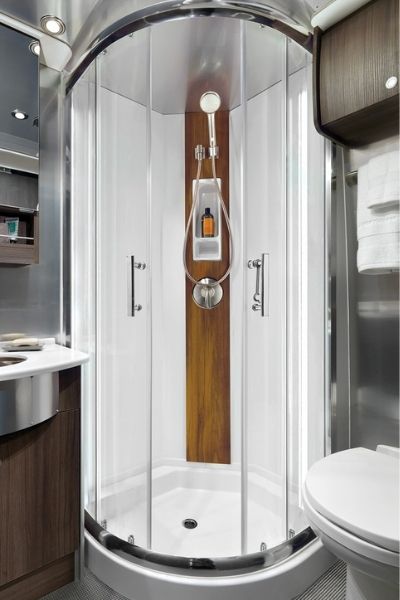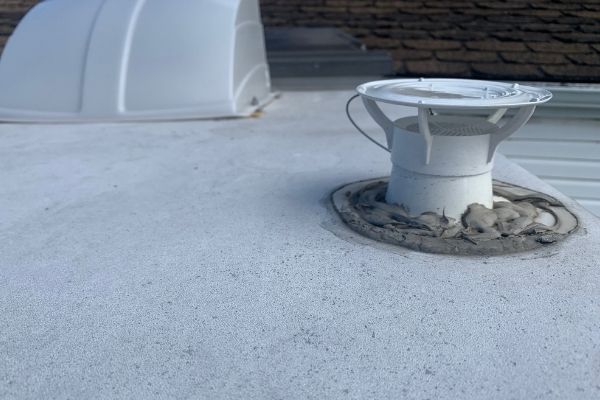An RV vacation might be fun, but not sure if they have a bathroom. It’s good to know that most RV’s do have bathrooms. All newer Class A, B & C motorhomes, trailers, and 5th wheels all have bathrooms. While larger teardrops have small wet baths and some larger tent trailers may have a toilet and zip-up privacy screens in the tent. Technically, these privacy screens are not a bathroom.
Bathrooms in RVs come in 2 types: Wet Baths and dry baths. Dry Baths have separate areas, and wet baths have the shower, toilet, and sink in the same shared space, all designed to get wet.
Although RV bathrooms appear to very similar to your home’s bathroom, the affluent and dirty water does not go straight into a sewage system, instead it goes into several storage tanks; a grey tank and a black tank, that is empties later into an RV waste disposal system. So let’s look closer at the two types of bathrooms in RVs and then what happens to the wastewater in the storage tanks and finally discuss dumping the tanks.
RV Wet Bath VS Dry Bath: How Do You Shower?
Both wet and dry baths have a shower, the difference is in what gets wet when you shower. The bathrooms in either style have water supplied either from an external source or from the internal water storage tanks. A hot water tank onboard the RV heats the water for the shower and sink.
In a wet bath the footprint is very small typically 3 feet by 3 feet some are as large as 4 X 3 feet. Showering is usually done sitting on the lid of the toilet, with a handheld shower attached to the sink faucet. A diverter sends water to the shower head.
The water drains at the foot of the toilet on the floor. Wet baths are typically very small and difficult to move around in. Recently some RV’s now come with a ½ door with the lower half closed and the upper half covered by an outer curtain and thus allowing for better movement when showering.

Dry Baths on the other hand have a dedicated shower and shower basin that catches the water from the shower head. The shower head can be fixed or have hose and handle. The size of the shower can be the size of a typical home shower stall. The size of a dry bath can be 3 to 4 feet by 5 to 6 feet or larger. Some Dry baths in luxury RVs such as Class A and super C motorhomes can be as large as a medium-sized bathroom in a house.

Either way, both styles of bathrooms empty the wastewater into the storage tanks below. Grey for the shower and sinks, while black for the toilet.
How Do RV Waster Water Tanks Work?
RV wastewater tanks are storage tanks for effluents, which naturally have biological actions as the breakdown of waste begins to occur until it is dumped at a RV dump station.
The Grey water, which is all the wastewater from the sinks and shower. A dark water tank is attached to the toilet. Ventilation pipes attached to the top of each tank vents the gases to the roof of the RV. A common complaint among Camper owners is that their RV smells like a sewer or Why does my camper smell like poop?

The reason your RV smells like sewer or poop is because there is a buildup of bad anerobic bacteria that are thriving in the absence of oxygen and not enough Aerobic Bacteria that helps to break down the waste and eliminates the odor. The smell is hydrogen sulfide gas produced from the bad bacteria.
This is due to a buildup of bad anaerobic bacteria that are thriving in the absence of oxygen and not enough of the Aerobic Bacteria that helps to break down the waste. The smell is hydrogen sulfide gas produced from the bad bacteria.

A backdraft of fumes from the storage tanks enters the coach through the toilet flap and sinks when there is not proper ventilation occurring or when there’s not enough of the beneficial bacteria exists. Here’s an article that goes into greater detail on Why Does My RV smell like sewer?
How Does RV Wastewater Ventilation Help To Eliminate Odors?
Oxygen is one part of the process that helps to break the wastewater, the other is the good bacteria. Namely Bacillus bacteria, which create enzymes that rapidly break the waste down. Really no different than what occurs in a sewage treatment plant. The waste ventilation provides a means for the gases to escape and have oxygen enter the system to aid in the process of breaking down the waste.

However, the typical RV vent cover does not always encourage enough venting of the wastewater gases from the tanks and thus increase the bad bacteria and hydrogen sulfide gas smell or sewer smelling RV. A properly vent wastewater tank will eventually create enough of the beneficial bacteria to eliminate the smell on its own, but the process could take a few days depending on the weather and other conditions.
How Does Bacteria Help To Eliminate Sewer Smelling RV Toilets?
The Quickest way to eliminate the hydrogen sulfide gas or sewer smell is to add beneficial bacteria to your grey and black water tanks. Within 3 to 4 hrs the smell magically disappears.
By adding beneficial bacteria, you are accelerating the process that would have occurred if the right conditions existed.
There are several digestive enzymes on the market that work well to increase the beneficial bacteria. My favorites are a happy camper and Unique RV digest as they simply work well.

When Do You Dump Your RV Wastewater Tanks?
Dumping your wastewater can be done at any time. However, it’s best to dump them when they are greater than 60 percent full to 99% full. Fuller tanks have a greater push in flushing everything out of the tanks.
I follow the flush till it’s clear method, as I have found with testing that it is simply the best way to get everything out of the waste tanks. There are lots of discussion on the internet of people saying to put ice cube in the tanks and I have done it all. None of them work nearly as well as the flush till it’s clear method.

Here’s how you do it. After you have dumped your black water tank and you have pushed the stop back in and you are now emptying the grey water. Fill up your dark water tank with the water at the RV dump station till you cannot hear the water going into the dark water tank and then pull the leaver to flush the waste out. You would repeat this process 3 to 4 times till the clear section of your dumping hose only has clear water.
If you have never dumped at an RV dump station, I wrote an article that goes into greater detail that you can read more about it.
Common Questions
Here’s Some Common Questions new RVers ask.
Can You Poop In An RV Toilet?
Pooping in an RV toilet is perfectly acceptable and has been designed to handle poop and pee. The waste goes into a dark water tank, where biological activity begins to break down the excrement. A common complaint among RVers is that their RV smells like manure. This is hydrogen sulfide gas from the lack of proper ventilation and the lack of beneficial bacteria. The quickest way to eliminate this smell is to add beneficial bacteria from products like Unique or happy camper.
Where Does The Poop Go In An RV Toilet?
The poop goes into a tank called the black tank, it is attached to the bottom of the toilet and is separated by a toilet flap that keeps the smells and gases in the tank. A vent is at the top of the black water tank that opens at the top of the camper that lets the gases from the waste in the black water tank escape. The roof vent of the black tank creates a positive air pressure system that is supposed to keep the odors from getting into the coach of your RV.
Can You Use Regular Toilet Paper In Your RV Toilet?
The use of regular toilet paper is not advised to be using in your RV toilet as regular toilet paper is much thicker and takes longer to dissolve than RV toilet paper that is much thinner and breaks down faster. Using regular toilet paper can result in a black tank getting blocked up with waste and toilet paper and not be able to flush. Plus it can also block the sensors in the tank from working properly and it will show that the black tank is always full when it is empty. It’s best to use rapid dissolve toilet paper that is safe for RVs.

What Brands Of Toilet Paper Are RV Safe?
Getting the right toilet paper is important for your RV, using the wrong toilet paper can be hours spent and hundreds of dollars spent fixing the problem. That which quite frankly can be very unpleasant. So when you go to load up your RV with toilet paper make sure that it says that it is marine or RV safe toilet paper. Either way here’s a list of the most common toilet paper that most RVers use.
- Camco RV & Marine Toilet Paper
- Scott Rapid-dissolving
- Aqua-Soft Toile Tissue
- Freedom Living Toilet Tissue
- Natures Call Toilet Tissue
There are quite a few brands on the market. To be honest, they are all pretty much the same. They are 1-ply ultra thin toilet paper that rapidly breaks down in water is what you want. Make sure that they say they are RV and marine safe. If you are budget conscious go for the cheapest that you can find.
Can You Use Bleach Or Other Chemicals In Your RV Toilet?
Using Bleach and other chemicals is really not advised as it will affect the good bacteria that control the smell from the black water tank. It’s better to use good bacteria toilet treatments such as a happy camper or Unique. Depending on the chemicals it could have a really bad effect on the plastic tanks itself. It’s best to stick with what the black tank was designed for, which is waste and toilet paper.

Can You Flush Wipes Down An RV Toilet?
Although flushable wipes are advertised that they can be flushed down a toilet, doing so in an RV toilet can result in a blocked black tank and a smelly mess! It’s best to stick with just RV safe quick dissolve toilet paper, poop and pee. A used flushable wipe can be thrown in the garbage next to the toilet after use.




